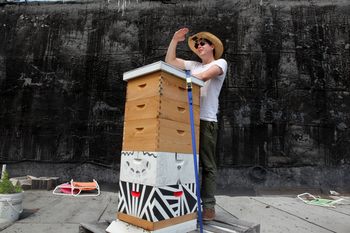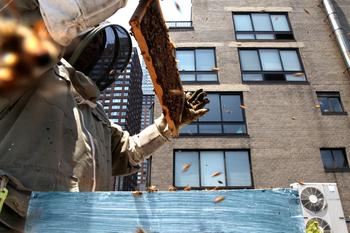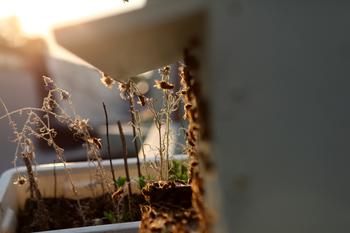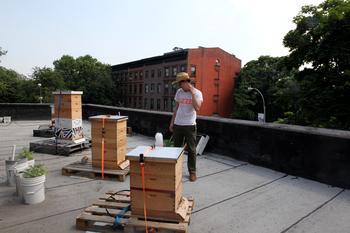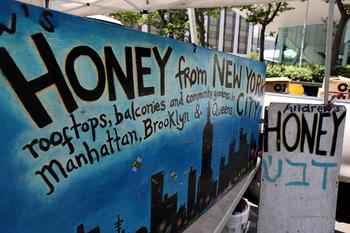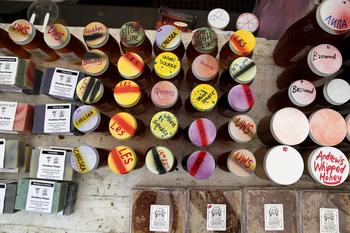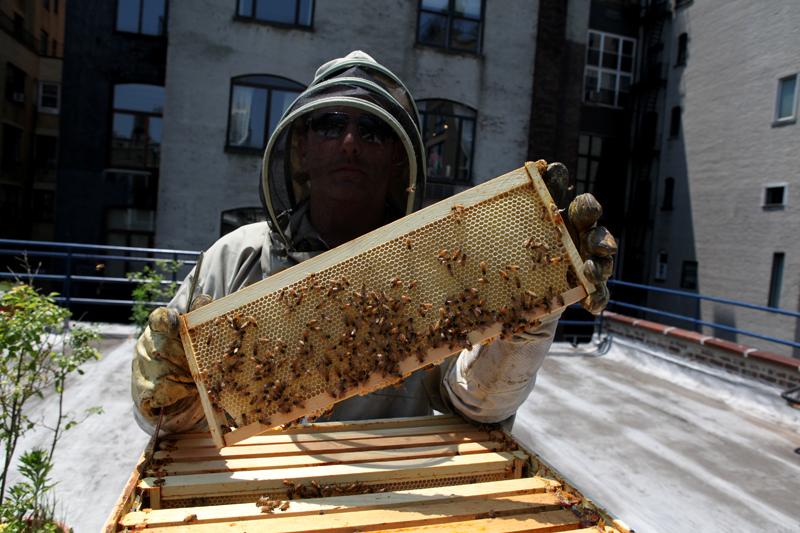
New York has been a hive of activity since a certain rural hobby was legalized in 2010. Urban beekeeping has exploded with nearly 200 registered hives in the city, and experts say there may be another 200 off the books. It’s leading some to question whether the city can sustain the increasing number of hives.
On the roof of York Prep School on the Upper West Side beekeeper Andrew Cote, 40, peels off the tin top of a hive and pops out one of nine wooden frames. It’s covered by agitated honey bees.
“They’re working, they’re attending to their babies,” he said.
He turns over the honey comb-filled frame wearing elbow length leather gloves. A cloud of bees hovers around his veiled face.
Satisfied, he gingerly slides the tray back into the hive like a folder in a file cabinet.
Cote works with the school’s beekeeper club and assists with a curriculum on bees. He also harvests the honey to sell.
With hot summer temperatures, Cote is concerned about his bees getting enough water and not overheating.
It’s just not the heat that’s the problem. Like everywhere else in New York, there seems to be a shortage of available real estate. Cote worries there are not enough flowers to support the growing bee populations — especially in certain neighborhoods where beekeeping has blossomed.
Cote, who helped write the guidelines for good bee keeping, may be part of the problem, too. He tends about 50 hives in the city.
He sells his “hyper local” honey at city farmer’s markets, where some small jars go for as much as $20. But his honey yields are down about 50 percent from last year at some hives in the East Village, Union Square, Greenpoint and Williamsburg.
In London, where beekeeping was never illegal, experts say too many hives concentrated in certain neighborhoods led to starving bees. Angela Woods, secretary at the London Bee Keepers Association, said her city could be a preview of what’s coming for New York.
“What happens is they don’t get enough pollen and nectar and people feed them on syrups, and it’s the equivalent of eating hamburgers for six months,” Woods said.
Malnourished bees? Tim O’Neal, who keeps four hives in Fort Greene, doesn’t buy it. He notes that bees often travel three to five miles to forage — so Fort Green and Prospect Park are well within reach of the bees on his block.
O’Neal started keeping bees in junior high in Ohio. He eschews a bee suit and veil, preferring long pants, a T-shirt and straw hat. Crouching down on the hot roof near the opening at the bottom of the hive’s box, where busy bees are flying in and out, he listens to the hum.
“The buzz you’re hearing, is within a hertz or two of middle C on a piano,” he said. That's the pitch that confirms his bees are happy bees.
He knows if his bees are mad that C will rise to a C sharp. “If you’ve ever played any kind of instrument, if you’ve been in a choir, you’ll notice it, it sounds a little bit crankier than this pleasant middle C buzzing.”
The city requires bee keepers to register their hives, but it doesn’t regulate how many are kept in each neighborhood.
Anthony Planakis knows the sound of cranky bees. He’s the NYPD officer who handles many of the city’s bee situations. The 18-year veteran has kept bees since 1977 and says there should be one hive per acre of green space.
And space is getting pretty tight now in the city.
When bees run out of flowers, “what’s going to happen is that these bees might turn around, they might split or swarm going toward the east — just in search of more suitable foraging grounds,” he said.
While there have been confirmed reports of increased swarms since last year, Officer Planakis said the majority of the swarms he saw were from feral hives — not urban beekeepers.
If you see a swarm, call 311 or contact one of the bee keeping associations in the city, like Beekeepers Association or NYCbeekeeping.org.

